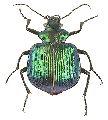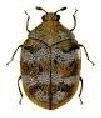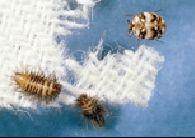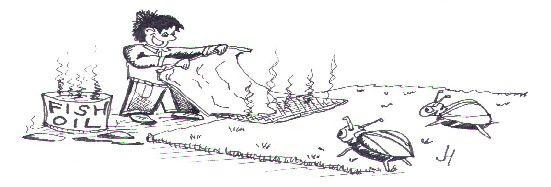Natural Solutions to Things That Bug You (44 page)
Read Natural Solutions to Things That Bug You Online
Authors: Myles Bader

BLISTER BEETLE
Identification:
 Blister beetles are black, flying beetles that may have yellow stripes and are about ½ inches long. They have long legs and a narrow neck. They will cause a blister on your skin if handled. They will also eat leaves, fruit and stems of plants.
Blister beetles are black, flying beetles that may have yellow stripes and are about ½ inches long. They have long legs and a narrow neck. They will cause a blister on your skin if handled. They will also eat leaves, fruit and stems of plants.
General Information:
If these beetles get into your garden it may be the end of the garden.
If a swarm gets in the best thing to do is to physically chase them out of the garden and as far away as you can. Chickens won’t even help since they get sick when they eat these beetles.
IT’S A BIRD, IT’S A PLANE, NO IT’S A FLYING BEETLE
These beetles are solid, black flying beetles. They have long legs and a narrow neck and will cause you to get skin blisters if you handle them. They prefer to eat leaves and fruit and will prey on grasshopper eggs making them somewhat beneficial.
If you handpick them use gloves and wash the gloves afterwards. Nc nematodes work well since they lay their eggs in the soil.
THE SAME OLD SPRAY
Lime sprays work very well and also dusting damp plants with lime will make them leave the garden area and head for a neighbor’s yard. As a last resort use a soap and lime spray or use pyrethrums.
CALOSOMA BEETLE
General Information:
 This is a well-known beetle that looks like an Egyptian scarab. The wings are covered with a metallic blue color and are slightly ridged with a red border. They have long legs and are very speedy and release a foul smelly chemical when bothered. Their favorite meal is the tent caterpillar.
This is a well-known beetle that looks like an Egyptian scarab. The wings are covered with a metallic blue color and are slightly ridged with a red border. They have long legs and are very speedy and release a foul smelly chemical when bothered. Their favorite meal is the tent caterpillar.

CARPET BEETLE
General Information:
 Carpet beetles enjoy munching on wool, feathers and even fur. These beetles actually are the ones that leave small round holes not the jagged hole that the clothes moth leaves in the clothing. Their larvae are hairy little worms that do most of the damage and they can live up to 3 years. If you give them the opportunity they will also dine on carpets, curtains and upholstered furniture. They will not feast on synthetic carpets or fabrics.
Carpet beetles enjoy munching on wool, feathers and even fur. These beetles actually are the ones that leave small round holes not the jagged hole that the clothes moth leaves in the clothing. Their larvae are hairy little worms that do most of the damage and they can live up to 3 years. If you give them the opportunity they will also dine on carpets, curtains and upholstered furniture. They will not feast on synthetic carpets or fabrics.
Adult carpet beetles are oval and approximately 1/8 inch long and uniformly dark brown-black and shiny. Carpet beetle larvae are elongate, reddish or light brown and covered with short hairs. Some species have distinct tufts of hairs extending from the posterior and their larvae repeatedly shed their skins and these old larval skins are often confused with the living insects. The full grown, the larvae are about 1/8 inch long.
| |
| |
The larvae feed on various materials of animal origin and commonly occur in bird nests, while adult beetles feed on the pollen of plants. Most household infestations originate from these wild populations. Carpet beetles also may be carried about by moving infested items. Inside the home, the female beetles lay eggs over a period of about three weeks. Common egg laying sites include areas anywhere dead insects occur, in accumulations of lint in dryer air ducts, along borders of carpeting and behind baseboards.
The eggs hatch in 10 to 20 days and the new larvae search for food. Depending on the quality of the food source and the temperature, the larvae become full grown in 2 to 11 months.
 If you find the source of the problem, remove and destroy the infested material if possible. If you place small items in the freezer for 48 hours or heat-treat them at temperatures above 120
If you find the source of the problem, remove and destroy the infested material if possible. If you place small items in the freezer for 48 hours or heat-treat them at temperatures above 120
F for several hours.
DANGER! BAD BUG LIVES HERE
Carpet beetles do a lot of damage to fabrics every year, even more than clothes moths.
They are difficult to get rid of once they get a foothold and love to munch on pet hair as well. One of the best methods of eradication is to vacuum frequently.
HERE LITTLE BEETLE, COME TO FISHY

 Carpet beetles are attracted to fish oil and if you place some sardine oil on piece of flypaper or any sticky surface it will attract them into a trap. However, if you do this in your closet don’t expect to have too many friends.
Carpet beetles are attracted to fish oil and if you place some sardine oil on piece of flypaper or any sticky surface it will attract them into a trap. However, if you do this in your closet don’t expect to have too many friends.

CIGARETTE BEETLES
General Information:
 The cigarette beetle will feed on a variety of stored products such as paprika, chili, and dried dog or cat food. Both adults and larvae are capable of penetrating almost any type of packaging material. These small destructive pests can even feed on pyrethrum powder strong enough to kill cockroaches and most other insects. Adults are strong fliers and are attracted to light at night. In fact, flying around lights at night is often the first indication of their presence.
The cigarette beetle will feed on a variety of stored products such as paprika, chili, and dried dog or cat food. Both adults and larvae are capable of penetrating almost any type of packaging material. These small destructive pests can even feed on pyrethrum powder strong enough to kill cockroaches and most other insects. Adults are strong fliers and are attracted to light at night. In fact, flying around lights at night is often the first indication of their presence.
Cigarette beetles are native to Egypt and a beetle was found in King Tutankhamen's tomb! In the 3,500 years since then the beetle has hardly changed. The adult cigarette beetle is a tiny red-brown to yellowish-brown beetle and when viewed from above it appears oval and in profile humpbacked in shape.